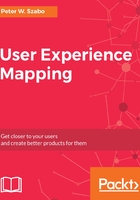
What this book covers
Chapter 1, How Will UX Mapping Change Your (Users') Life?, gets the reader started with User Experience Mapping in a fun and engaging way. In this chapter, we will create a simple map, not worried about map types and UX mapping theory. We will use pen and paper, to give the reader the first taste in mapping and demonstrate its strength.
Chapter 2, User Story Map - Requirements by Collaboration and Sticky Notes, is a simple technique to visually tell the users' story. The linear map helps you create a narrative flow. Because it's quick and easy, it can be used in the early ideation phase of a product.
Chapter 3, Journey Map - Understand Your Users, the journey maps is a tool, that helps us to understand and communicate users' behavior as they progress through a route using interactions, trying to accomplish their goals.
Chapter 4, Wireflows - Plan Your Product, wireflows are journey maps where key interactions are represented by wireframes of the relevant views. They allow you to create, explore, communicate, and improve the interactions in detail.
Chapter 5, Remote and Lab Tests for Map Creation, by watching users while they interact with a solution, we gain understanding. This understanding leads to better maps and better experiences.
Chapter 6, Solution Mapping Based on User Insights, a solution map is a tool that will help us find solutions and communicate them. They are visual representations of an actionable project plan. Ideally, solution maps should be based on user testing sessions with real users.
Chapter 7, Mental Model Map - A Diagram of the Perceived Reality, a mental model map is a visual representation of a user group's thought process and patterns. The mental model shifts the focus from designing a solution to understanding the user's state of mind, and how we can support those states.
Chapter 8, Behavioral Change Map - The Action Plan of Persuasion, a behavioral change map is a path to changing a user group's behavior. It should be simple and impactful, based on a real understanding of our user's mindset and thought processes.
Chapter 9, The 4D UX Map - Putting It All Together, the 4D UX map is a compact summary of a UX project, a high-impact deliverable to visualize how the users' needs are met.
Chapter 10, Ecosystem Maps - A Holistic Overview, the ecosystem map places our solution in the greater context of the holistic user experience. This map aids the identification and integration of complex, interdisciplinary information concerning the user experience ecosystem.
Chapter 11, Kaizen Mapping - UX Maps in Agile Product Management, you can use the Kaizen-UX framework to structure your product design and user experience efforts. The agile framework defines the three core roles within the UX team, it has a UX strategy at its core, and it leads to better products and better communication within the team and with stakeholders.